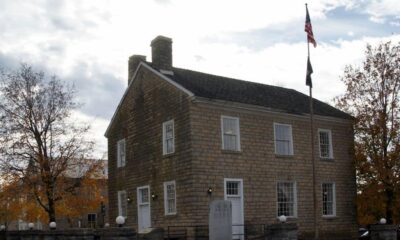News from the South - South Carolina News Feed
House GOP grinding ahead with Trump’s big tax cuts bill, but new report says it will add to deficit
SUMMARY: House Republicans, led by Speaker Mike Johnson and President Trump, aim to vote on a multi-trillion-dollar tax break package by Wednesday, surmounting GOP doubts about increasing the $36 trillion national debt. The Congressional Budget Office projects the tax cuts will boost the deficit by $3.8 trillion over ten years, partly offset by $1 trillion in safety net spending cuts affecting Medicaid and food stamps, reducing benefits for low-income households. The bill extends Trump’s 2017 tax breaks, cuts green energy incentives, adds $350 billion in spending for defense and border security, and imposes work requirements on federal aid recipients. Despite internal GOP tensions and Democratic opposition, Trump pushes for passage to fulfill his legislative priorities.
The post House GOP grinding ahead with Trump’s big tax cuts bill, but new report says it will add to deficit appeared first on www.abccolumbia.com
News from the South - South Carolina News Feed
At least five children injured in a shooting at a Minneapolis Catholic school
SUMMARY: On August 27, 2025, a shooting at Annunciation Catholic School in Minneapolis injured at least five children during the first week of classes. Authorities contained the shooter, and no active threat remained. Governor Tim Walz called the incident “horrific” and expressed prayers for those affected. Children’s Minnesota and Hennepin Healthcare treated the injured. The school was evacuated, and families were directed to a reunification zone. The shooting followed multiple fatal shootings in Minneapolis within 24 hours and came amid a wave of hoax shooting calls on U.S. campuses. President Trump and local officials monitored the situation closely.
Read the full article
The post At least five children injured in a shooting at a Minneapolis Catholic school appeared first on www.abccolumbia.com
News from the South - North Carolina News Feed
Spending on classrooms by NC teachers among highest in US
Teacher pay has been a long and storied battle in North Carolina, with the state consistently ranking among the lowest teacher salaries in the country. But while educators are often pinching pennies and stretching dollars to make ends meet, a new report from CouponBirds shows North Carolina teachers are spending an average of $1,632 out of their own pockets to supply their classrooms.
That’s the second-highest in the country according to the study, just $5 less than Pennsylvania teachers. It’s a 22% increase from the average amount NC teachers spent in 2024 and is well above the report’s national average of $1,021.
President of the North Carolina Association of Educators Tamika Walker Kelly told Carolina Public Press that teachers tend to spend the most money on consumable products like notebook paper, pencils, tissues and cleaning wipes. While many teachers will ask parents to purchase these supplies for their children — or even for communal use — at the beginning of the school year, Kelly noted that families are often experiencing economic hardships themselves.
[Subscribe for FREE to Carolina Public Press’ alerts and weekend roundup newsletters]
“Educators stand in the gap most of the time to provide resources for students and families who cannot afford them,” she said. “And we have to turn over those resources throughout the year — not just at the beginning of the year, but throughout the duration of the academic season.”
It’s a national trend for teachers to post their “classroom wishlists” online in hopes good Samaritans will purchase some of the items. Kelly said crowdfunding for supplies is nothing new to NC teachers, but it has become more routine as resources have shrunk.
“Unfortunately, that has become more commonplace, but it shouldn’t be because we need our North Carolina legislators to invest in the basic resources that our students need in order to thrive,” she said.
“We should not be dependent on crowdfunding our classrooms when we have a constitutional obligation to make sure that every student has the resources that they need here in our state.”
In the wake of slimmed budgets and decreased resources, teachers often have to get creative to make ends meet in the classroom.
Kelly told an anecdote of a teacher who cut composition books in half to double the amount of notebooks she was able to distribute to her students. A more common hack is to wrap a rubber band around hand sanitizer dispensers. This limits the amount that comes out of the bottle, prolonging the bottle’s life span, Kelly said.
Many educators already work second jobs to pay for their supplies each year or simply to sustain their lifestyle, Kelly said. Additionally, teachers can also be parents who have to purchase supplies for their own children on top of stocking their classroom.
“For our educators to be spending as much money as they do to supply their own classrooms, in contrast to the data that shows that we are one of the lowest-paid states in the nation for educator pay really highlights the dissonance and the really deep investments in care that our educators take into putting into their classroom versus the lack of care that our lawmakers are putting in to making sure that we continue to retain these educators,” she said.
Finding solutions for classroom spending
Madeline Blobe is the executive director of the Chapel Hill-Carrboro Public School Foundation, a nonprofit that raises additional funding for schools in the area.
The organization funds scholarships, innovative projects and teacher awards, as well as offering a Teacher Supply Store for educators to “shop” for classroom supplies. They work closely with the East Chapel Hill Rotary Club, which does 85% of the fundraising for PSF each year.
The supply store is meant to defray some of the financial burdens teachers face when it comes to stocking their classrooms by spending out of their own pockets, Blobe said. This year, more than 1,100 teachers in the district will be able to “purchase” $50 worth of supplies from the store for free of charge. Available items range from two composition books for $1 to an electric pencil sharpener for $30.
“If you’re at the store, you feel it — what this means to teachers, how happy it makes them all. It seems like a little thing, but it really is a big thing to them,” Blobe said.
“They’re obviously devoted to their jobs or they wouldn’t come to work. They have very hard jobs. They’re not paid well. It’s obviously a passion for them, but it is definitely the generosity of our community that means a lot.”
Although PSF is a nonprofit organization and cannot lobby for legislation or political causes, Blobe said she does feel it is her responsibility to keep her donors and community informed about the state of education resources.
While generosity from the community is something teachers undoubtedly appreciate and sometimes even depend on, it is ultimately the state’s responsibility to fund public schools and ensure access to a quality education, Kelly said.
That starts with investing in students and increasing the access educators have to resources, as well as raising teacher pay for both new and veteran teachers, she said.
“We believe that dual investment, both in the overall funding of our public schools but also investing in comprehensive educator pay increases, will help us address this issue so that we don’t continue to face it in the future,” Kelly said.
National trends
Executive Director of AdoptAClassroom.org Ann Ruhr Pifer said the organization was designed to relieve the burden of teachers spending out of their own pockets. In North Carolina, 766 teachers are currently seeking support from the organization, which supplied 680 classrooms during the 2024-2025 school year.
Teachers create a page on the website detailing their classroom needs and what they hope to spend any donated funds on. Donors can decide to donate to individual teachers, a school or directly to AdoptAClassroom.
Any donations that a teacher receives goes into an account managed by the organization and can only be spent on an e-commerce marketplace containing educational and office supplies vendors. No money changes hands, and items are shipped directly to the teacher’s school.
Similarly to PSF, AdoptAClassroom sees its role as meeting the immediate needs of teachers across the country. But it’s not about simply choosing to focus on charity or legislation, Pifer said.
“Today, those funds can get right into the classrooms. Changing public education funding is a bigger issue,” she said. “And when I’m talking to potential donors or speaking to groups, I always say it’s not an ‘either, or’ — it’s a ‘yes, and.’”
Since the COVID-19 pandemic, AdoptAClassroom saw increased awareness from donors and teachers alike. Pifer said she thinks the pandemic drew attention to how much teachers do, so people felt more inclined to offer help. But teachers also struggled more and sought additional support.
AdoptAClassroom has conducted its own studies on teacher spending, and it found that teacher spending has increased 50% in the last 10 years. It’s clear that the burden has increased for teachers, and many are concerned that inflation is playing a role, Pifer said.
Not only does inflation impact the price of items directly, but it creates a domino effect across school districts.
“In talking to school principals, I realized that it also has a significant indirect effect. So inflation, and cost increases driven by many things, is increasing the cost of janitorial supplies, services that the school depends on, supplies and services just to run the school,” Pifer said.
“So now the principal’s budget is strained too, and maybe they used to be able to give teachers $200 for classroom supplies. Maybe now they can only give them $100 or maybe nothing. It may be gone, because the inflation pressure on the school budget is significant.”
A viral video recently sparked controversy when a parent voiced concerns online about her experience at her child’s teacher’s classroom at an open house. She was underwhelmed by the classroom, specifically the empty bins and lack of a rug.
Teachers responded in droves, explaining how they are largely expected to supply and decorate their rooms by spending their own time and money. So while many teachers are focused on essential supplies, there is often still an expectation for a decked-out classroom.
Blobe said decorative items, like soft lighting fixtures and posters, tend to fly off the shelves quickly at the Teacher Supply Store when they are lucky enough to have them available. Teachers also like to purchase items like rugs or comfortable seating options through AdoptAClassroom, Pifer said.
Kelly said she is concerned about the increasing financial burden on teachers contributing to teacher burnout. Some teachers are getting to a point where they have to make tough decisions and opt not to stock their classrooms by spending as heftily as they typically would, she said.
In the worst cases, teachers are leaving the classroom entirely. Sometimes they’ll leave to work for education-related companies where they can still utilize the same skills. Other times, they’ll step away from education altogether. Kelly cited the “educator to real estate pipeline” as one example.
“Many educators are choosing to leave the profession or are being pushed out of the profession because it is no longer sustainable for them and their families, and that is why we are continuing to deal with the educator shortage here in North Carolina,” she said.
“And until it is adequately and properly addressed through the North Carolina General Assembly, we’ll continue to see educators be pushed out of a career that they love to do, into the private sector, or into other states that compensate their educators more.”
This article first appeared on Carolina Public Press and is republished here under a Creative Commons Attribution-NoDerivatives 4.0 International License.
The post Spending on classrooms by NC teachers among highest in US appeared first on carolinapublicpress.org
Note: The following A.I. based commentary is not part of the original article, reproduced above, but is offered in the hopes that it will promote greater media literacy and critical thinking, by making any potential bias more visible to the reader –Staff Editor.
Political Bias Rating: Center-Left
This content emphasizes challenges faced by public school teachers, particularly low pay and the burden of self-funding classroom supplies, while advocating for greater state investment in education. It highlights systemic issues and includes calls for legislative action to increase funding and teacher salaries, which aligns with center-left perspectives prioritizing public sector support and social investment. The tone is sympathetic to educators and critical of insufficient government funding, but it remains measured and fact-based without heavy partisan rhetoric.
News from the South - South Carolina News Feed
Wall Street holds steady just below recent records
SUMMARY: Stocks hovered near recent highs Tuesday morning as the S&P 500 remained steady, the Dow dipped 0.1%, and the Nasdaq rose 0.2%. Boeing gained 2.2% after Korean Air’s $50 billion aircraft deal, while EchoStar surged 77% following AT&T’s $23 billion spectrum purchase. Treasury yields were mostly unchanged. Market caution followed President Trump’s intensified conflict with the Federal Reserve, including his attempt to remove Governor Lisa Cook. Despite political pressure, the Fed is expected to cut interest rates in September amid concerns over inflation, tariffs, and a weakening job market. Consumer confidence slightly declined, and global markets fell.
Read the full article
The post Wall Street holds steady just below recent records appeared first on www.abccolumbia.com
-
News from the South - Arkansas News Feed6 days ago
New I-55 bridge between Arkansas, Tennessee named after region’s three ‘Kings’
-
News from the South - Texas News Feed4 days ago
DEA agents uncover 'torture chamber,' buried drugs and bones at Kentucky home
-
News from the South - Missouri News Feed6 days ago
Missouri settles lawsuit over prison isolation policies for people with HIV
-
News from the South - Louisiana News Feed7 days ago
Families with citizen children deported by ICE sue Trump administration
-
Local News7 days ago
Picayune Police Department increases effectiveness of drug busts, leading to decrease in offenses
-
News from the South - Georgia News Feed7 days ago
Bookman: Here’s how Georgia’s 2020 election crisis will factor into 2026 GOP campaigns for governor
-
News from the South - Virginia News Feed6 days ago
Erin: Tropical storm force winds 600 miles wide eases into Atlantic | North Carolina
-
Our Mississippi Home6 days ago
Vardaman: The Sweet Potato Capital Serving Up Love, Tradition, and Flavor at Sweet Potato Sweets










































